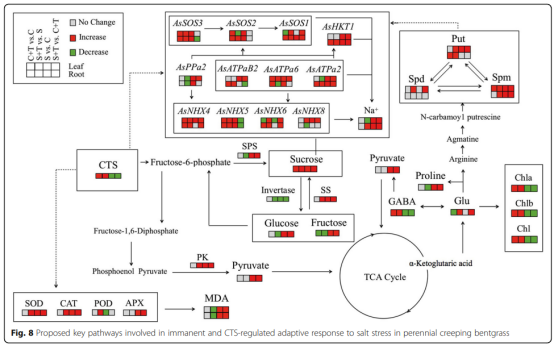Chitosan regulates metabolic balance, polyamine accumulation, and Na+ transport contributing to salt tolerance in creeping bentgrass
2022年03月11日 16:10
DOI:10.1186/s12870-020-02720-w
Wan Geng,Zhou Li,Muhammad Jawad Hassan,Yan Peng.
发表期刊:BMC Plant Biology
链接:https://www.researchgate.net/publication/345815532_Chitosan_regulates_metabolic_balance_polyamine_accumulation_and_Na_transport_contributing_to_salt_tolerance_in_creeping_bentgrass
Abstract:
Background Chitosan (CTS), a natural polysaccharide, exhibits multiple functions of stress adaptation regulation in plants. However, effects and mechanism of CTS on alleviating salt stress damage are still not fully understood. Objectives of this study were to investigate the function of CTS on improving salt tolerance associated with metabolic balance, polyamine (PAs) accumulation, and Na⁺ transport in creeping bentgrass (Agrostis stolonifera). Results CTS pretreatment significantly alleviated declines in relative water content, photosynthesis, photochemical efficiency, and water use efficiency in leaves under salt stress. Exogenous CTS increased endogenous PAs accumulation, antioxidant enzyme (SOD, POD, and CAT) activities, and sucrose accumulation and metabolism through the activation of sucrose synthase and pyruvate kinase activities, and inhibition of invertase activity. The CTS also improved total amino acids, glutamic acid, and γ-aminobutyric acid (GABA) accumulation. In addition, CTS-pretreated plants exhibited significantly higher Na⁺ content in roots and lower Na⁺ accumulation in leaves then untreated plants in response to salt stress. However, CTS had no significant effects on K⁺/Na⁺ ratio. Importantly, CTS enhanced salt overly sensitive (SOS) pathways and also up-regulated the expression of AsHKT1 and genes (AsNHX4, AsNHX5, and AsNHX6) encoding Na⁺/H⁺ exchangers under salt stress. Conclusions The application of CTS increased antioxidant enzyme activities, thereby reducing oxidative damage to roots and leaves. CTS-induced increases in sucrose and GABA accumulation and metabolism played important roles in osmotic adjustment and energy metabolism during salt stress. The CTS also enhanced SOS pathway associated with Na⁺ excretion from cytosol into rhizosphere, increased AsHKT1 expression inhibiting Na⁺ transport to the photosynthetic tissues, and also up-regulated the expression of AsNHX4, AsNHX5, and AsNHX6 promoting the capacity of Na⁺ compartmentalization in roots and leaves under salt stress. In addition, CTS-induced PAs accumulation could be an important regulatory mechanism contributing to enhanced salt tolerance. These findings reveal new functions of CTS on regulating Na⁺ transport, enhancing sugars and amino acids metabolism for osmotic adjustment and energy supply, and increasing PAs accumulation when creeping bentgrass responds to salt stress.
